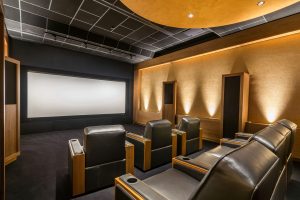The Benefits of Wood Wool Ceiling Tiles
When designing a ceiling, it’s best to choose a material that suits your personal style. You’ll quickly find you’ve got options—lots of them. Someone well-versed in ceiling styles can easily rattle off dozens of beautiful possibilities. With that kind of variety, it can be overwhelming for someone who’s just dipping their toes in the water. It doesn’t need to be.
The first step in choosing is to identify what you want out of the material. Color, texture, and performance are all important considerations. If you’re looking for something that checks off all the boxes, wood wool is an incredible option. If you’re unfamiliar with what wood wool is or what its benefits are, you’re in the right place.
What is Wood Wool?
If you’ve never heard the term wood wool before, it can sound a little confusing. Wood and wool are two diametrically opposed concepts. Hard logs and boards seem much different from the soft, intertwined hairs that make up wool. Once you understand the concept, however, it makes much more sense.
Also known by the generic term excelsior, wood wool is composed of slivers of wood that are cut from logs. Wood wool specifically refers to higher quality excelsior. It can be used in packaging, cooling pads, and a number of other applications. When it comes to wood wool ceilings, more goes into the production than simply bundling wood slivers.
Wood wool ceiling panels are produced by combining excelsior, water, and Portland cement. These three natural components are heated and pressed into panels. This process creates a superior building material that’s suitable for all kinds of applications. Aside from their simplistic composition and affordability, there are benefits of going with wood wool that may surprise you.
The Benefits of Wood Wool Ceilings
Going with wood wool ceiling panels in your interior design actually provides a wide range of amazing benefits. From acoustic control to possible LEED certification, wood wool can improve the sound and reduce your carbon footprint. Let’s look at why the world is embracing this wonderful building material.
Visual Appeal
First and foremost, any ceiling tile has got to look great to work in our interior spaces. If it doesn’t look good, what’s the point in exploring your options at all? Fortunately, wood wool ceiling tiles deliver visual appeal in spades. Here’s how.
First, they are available in lots of different colors. If the color you’re looking for isn’t immediately available, not to worry. You can have them custom painted in any color you like. You can use bold colors, muted tones, or a combination of the two. Using all tiles of the same color can deliver a field of rich color. You can also mix and match colors to create eye-catching designs that turn your ceiling into a focal point.
Secondly, wood wool panels provide a ton of texture. The overlapping wood splinters create some very cool, organic textures. If you want to add even more, go with regular panels. They drop below the T-grid suspension system to create the appearance of tiles.
Sound Control
All that texture in the material gives wood wool ceiling panels fantastic sound control. In fact, it’s one of the biggest benefits to using them in your ceiling design. The porous nature of wood wool ceiling paneling allows it to trap sound waves better than wood plank drop ceilings. This is a huge bonus if your room experiences issues with echo and reverberation. For even more sound control, they are available with an optional acoustical backer.
Wood wool is also an excellent sound damping material. That means it impedes sound vibrations from passing from one side to the other. It’s one of the main components in a proper soundproofing plan. All these acoustic benefits will leave you with more quiet and serene indoor spaces. In fact, reducing noise in our interior spaces provides a host of benefits.
Chronic exposure to sounds over 70 decibels, about the volume of a washing machine, leads to hearing loss over time. The louder the sounds, the more likely they are to damage our hearing. Even at lower volumes, that exposure can cause problems with concentration and increase stress. Using wood wool ceiling tiles is a great way to reduce sounds and promote more stress-free spaces.
Thermal Insulation
Wood wool isn’t only great at blocking sound reflections. It is equally adept at blocking thermal transmission. That’s because wood acts as a natural insulator. It has lower thermal conductivity when compared to many other building materials. This means that adding wood wool to your interior design also adds some pretty effective insulation in the space. Going with wood wool insulation may even pay for itself over time by reducing your heating and cooling costs.
Fire Resistance
If you’re concerned with fire safety, you’ve found another thing that makes wood wool a great option. These tiles are both Class A fire-rated and pass the NFPA 286 fire test. This means they are extremely unlikely to contribute to the spread of a fire. Even though they are primarily composed of wood, their treatment with concrete makes them a poor fuel source for fires. That’s not the case with other wooden finish ceiling treatments.
Whether code requires it or not, choosing materials that won’t fuel fires is a great way to keep occupants safe. If code does require it, you can rest easy knowing that your material of choice meets those requirements.
Non-Toxic
Another safety element we are concerned with when it comes to building materials is toxicity. Many materials contain harmful materials. Often they are not toxic unless disturbed, but that doesn’t necessarily make them safe. If they are exposed by renovations or structural fires, many of these materials release those toxic chemicals into the air. Luckily, wood wool isn’t one of them.
Since the panels contain only wood, water and concrete, we’ve got nothing to worry about. None of these natural and organic materials is toxic to humans or animals. That makes them ideal for applications where the room is used by children or animals. They’re a great way to combine the drop ceiling tiles, wood look, and safety features we’re after.
Sustainability
Since they are constructed with just a few natural ingredients, wood wool ceiling panels are incredibly sustainable. Not only are these wood ceiling materials created with simple, organic components, but they are recyclable as well. They can even help you earn LEED credits. What are LEED credits and why do they matter? Good question.
LEED(Leadership in Energy and Environmental Design) is a green building certification program developed by the U.S. Green Building Council. Not only can getting certified save you money, but it’s a great thing to do for the environment. You’ll feel fantastic knowing you’re doing something to help your community.
Versatility
No matter where you want to use them, wood wool ceiling tiles are a viable option. Want to use them in a room where moisture is an issue? No problem. They are highly resistant to microbial and fungal growth. Want to use them in a room with high-end finishes? Wood look ceiling tiles are a great way to complement the other materials in the room. No matter what you’re trying to accomplish, wood wool ceiling tiles pull a lot of weight.
Get Help Picking the Right Type of Ceiling Tile
If you’re still unsure of what type of tile is right for you, reach out to the pros. We know how many ceiling tiles are on the market these days. We also appreciate how the choice you make can make or break your interior design. That’s why we’re always there to help you sift through your options to make the best choice.
Maybe you want the look of wood plank ceilings but want something with better acoustical performance. We can help you get both. Whether you want to learn more about your choices or how acoustic wood wool ceiling panels can benefit your design, we’ve got you covered.

















Leave a reply
You must be logged in to post a comment.